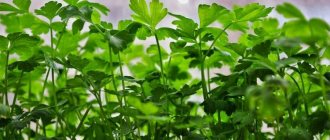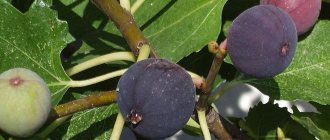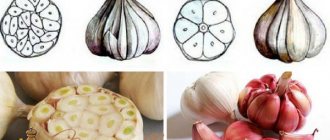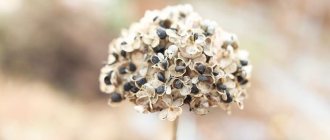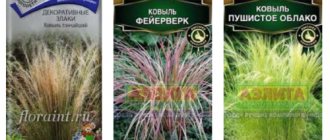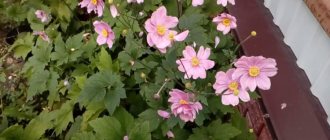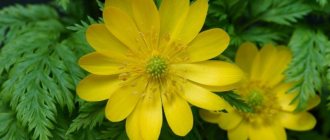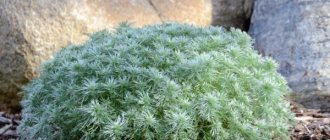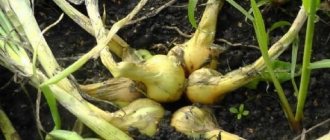Horseradish care
Timely care of horseradish plantings is crucial in obtaining a high yield and reducing production costs.
Work begins even before shoots emerge. The soil should not be compacted; it should always be loose. This helps conserve moisture, facilitates air access, improves the living conditions of microorganisms and promotes the accumulation of nutrients in the soil. A week after planting, you need to harrow the soil using a light rake. At this time, weeds are just beginning to germinate, forming a lot of whitish-pink “threads” in the soil. Timely loosening will destroy up to 80% of these seedlings, significantly cleaning the soil. Depending on the characteristics of the soil, the degree of contamination and weather conditions, treatment is carried out 1-2 times: before horseradish shoots and during their appearance.
In the future, caring for the plantings is reduced to carrying out 3-4 treatments between plants, 2-3 weedings and 1-2 hillings. Hilling of plants begins in mid-summer. With excess moisture, it promotes better drying and ventilation of the soil and an increase in its temperature. In dry years, it is replaced by loosening the rows.
On insufficiently fertile soils, plants are fertilized simultaneously with inter-row cultivation or before it. Horseradish is fed for the first time 3-4 weeks after planting, adding 5-10 g of ammonium nitrate, 7-10 g of superphosphate and 5-10 g of potassium chloride per square meter. The second time, fertilizing is done in mid-summer, simultaneously with hilling. Per 1 m² add 5-6 g of ammonium nitrate, 12-15 g of superphosphate, 8-10 g of potassium chloride. If the grown products are intended for winter storage, the doses of potassium fertilizers are increased. The specific timing of fertilizer application depends on the condition of the plants and weather conditions.
To obtain high yields of horseradish, watering is necessary, especially in the first time after planting, when leaves are growing rapidly and a significant amount of water is consumed for transpiration, and the still weak root system cannot provide the leaf apparatus with sufficient moisture.
Over the summer, several rosettes of leaves are formed on each plant. In this case, multi-headed rhizomes grow. To increase the marketability of products, at the beginning of summer, excess rosettes are cut off with a sharp knife, leaving no more than two on one plant.
On small plots in gardening conditions, in order to obtain marketable roots of higher quality, horseradish can be “trained” in late July - early August. To do this, in mid-summer, the soil is raked from the rhizomes and, with a sharp knife, the formed upper lateral roots are removed from the central rhizome by about 2/3 of its length and immediately hilled up. This technique allows you to increase the marketable yield and improve its quality. The rhizomes are smooth, with a minimum number of branches.
Horseradish rhizomes grow vigorously at the end of the growing season, so they should not be removed prematurely. In the conditions of the Leningrad region, the best time for harvesting is the end of September - the beginning of October, but you can also harvest in the spring. Moreover, due to the growth of rhizomes in late autumn, the spring harvest often exceeds the autumn one. However, it should be borne in mind that in the spring the plant begins to grow very early; flowering shoots often appear first, which consume the supply of nutrients deposited in the rhizomes. Delay in harvesting in this case not only reduces the harvest, but also reduces its quality.
When planting very small roots, the products do not reach marketable size by the fall, and they have to be left in the soil for the second year. In this case, the plants are buried deeply to prevent them from getting wet in the spring. In the second year, caring for such plants begins with removing dead leaves. They are raked and removed from the site. At the end of April - beginning of May, the plants are fed with 15-20 g of ammonium nitrate, 20 g of superphosphate and 10-15 g of potassium chloride per square meter.
Horseradish: three ways of planting
The soil for planting horseradish is prepared as follows: they dig up the soil to a depth of about 40 cm, into which fertilizers have already been applied before digging in the fall.
For 1 square meter - 5-9 kilograms of compost or rotted manure, 25 grams of urea, 50 grams of superphosphate and 35 grams of potassium chloride. If necessary, horseradish is grown in bulk beds.
Horseradish is propagated only by cuttings. Cuttings for planting material are prepared in the fall, when the horseradish crop is dug up. All small branches that are cut off from the rhizome are used for cuttings. Requirements for cuttings:
- For the southern regions - length about 25 cm, thickness not less than 0.5 cm.
- For the Central, North-Western regions and Siberia - length about 25 cm, thickness not less than 1 cm.
Since the planting material will have to be stored until spring, the lower part of the cutting is marked so as not to later confuse it with the upper. The easiest way to mark is by making an oblique cut. Store the cuttings in a cellar or basement, covered with any available material or buried in a box with soil. About a month before planting, the cuttings are brought into a bright room. To awaken dormant buds, cover the middle of the roots with burlap, and leave the upper and lower parts open. When the cuttings germinate, they are “blinded” just before planting in the prepared place.
The “blinding” procedure consists of removing all the buds from the middle of the cutting, which was under the burlap, both dormant and beginning to grow. “Blinding” is done with a hand dressed in a mitten, or with a piece of burlap. Buds that have begun to grow in the lower and upper parts of the cuttings are not removed.
"Blinding" helps prevent the formation of lateral branches of the rhizome, so that in the fall we will get cylindrical, even roots.
Now you can start planting the cuttings, which is done using planting pegs. A peg, which is about 5 cm longer than the cutting, is stuck into the prepared loose soil; the cutting is planted in the hole that will remain after the peg is removed. Here we will need an oblique cut made in the fall - it should be at the bottom. The cuttings are sprinkled with earth, the layer thickness is 3-5 cm, depending on the composition of the soil, the lighter it is, the thinner the layer should be. The distance between cuttings is 30 cm, between rows -70 cm.
We told you about vertical planting of horseradish; There are two more planting methods: horizontal and inclined.
For two-year-old cuttings, the maximum yield is from inclined cuttings. For annuals (planted in the spring and harvested in the fall), the maximum yield is for those planted horizontally.
But horizontal planting has a big drawback - it awakens many extra buds, the root will turn out to be branched, sloppy and inconvenient for storage.
Immediately after planting, we can “put the tambourine aside” until the fall - horseradish will not require any more dancing from us, we will only need to weed it a couple of times during the season and water it several times.
How to grow horseradish in the garden
The horseradish plant grows in many garden plots, filling all the free space in and around the beds. There is an opinion that if horseradish gets into the area, it is almost impossible to remove it.
At the same time, this culture is very useful when eaten and is used to prepare various seasonings and snacks.
Growing in open ground and caring for this crop does not require special knowledge; even inexperienced summer residents can do it.
A little about the plant and its use
In Russia, horseradish has been known since time immemorial and is one of the national spices, although its homeland is considered to be the south-east of Europe - the southern Mediterranean.
It has been mentioned in recipes for dishes and snacks since the times of Ancient Egypt, Greece and the Roman Empire, and then, by the 9th century AD, it appeared in Rus'.
Currently, it is distributed everywhere, right up to the regions of the Far North and the Caucasus.
Modern science classifies this crop as a member of the cruciferous family. It is a perennial herbaceous plant, sometimes reaching a height of 1.5 m, and usually looks like a bush. The root length can reach 50-70 cm.
The shoots stand straight, the stems are hollow, with grooves. The leaf blade is large and has a bright green color. Horseradish blooms with pretty white flowers, collected in inflorescences, usually from May to June.
By autumn, pod-shaped fruits containing horseradish seeds are formed. Flowering horseradish in the photo below.
The rhizome is of particular value, loved for its pungency and healing properties. The following substances were identified in its composition:
Thanks to such components, it has long been considered a natural antibacterial agent that can cope with many microbes, as well as malignant formations in the body. During periods of off-season exacerbations of ARVI, doctors advise gradually eating horseradish root along with garlic.
Many summer residents grow horseradish in their garden plots and use all parts of the plant in cooking - both leaves and roots. Growing horseradish in the garden is not particularly difficult.
Growing horseradish
This plant is very unpretentious and often grows in the garden like a weed, but if you want to get a good harvest, you need to put in a little effort.
When is the best time to plant
Horseradish is planted mainly in spring or autumn before winter. Since this is a cold-resistant plant, it will overwinter well, and in early spring, as soon as the ground thaws, it will produce young shoots. Many gardeners prefer spring planting, after the soil on the site has thawed and warmed up. In the middle zone this is approximately mid-April.
Some gardeners express the opinion that the survival rate and natural unpretentiousness of this crop allows it to be planted throughout the season. You can not only plant, but also replant horseradish throughout the summer. Planting horseradish in summer is done in the same way as spring or autumn planting.
Planting and care
Before planting cuttings, you need to thoroughly water the bed.
To bury the cuttings in the soil, a peg or a thick branch is used, which is stuck into the ground at an angle of 30 to 45 degrees to such a depth that 3 to 5 cm remains from the root to the surface of the ground.
The planting pattern is approximately 30 by 70 cm - 30 cm between roots, 70 cm between rows. After digging into the soil, the soil must be rolled so that it becomes compacted.
Due to the natural unpretentiousness of this crop, care, regardless of its variety, consists of loosening the soil, weeding, watering (in hot, dry weather) and protection from pests. Loosening should begin a week after planting, to a depth of 3-4 cm. Then, when the shoots grow by 20 - 25 cm, deeper loosening is carried out - up to 10 cm in depth. In total, you need to do this 3-4 times during the season.
Experts advise fertilizing seedlings with mineral fertilizers once a month. Before applying the working solution, you need to water the plants so that the fertilizer does not burn the horseradish roots.
With sufficient care, horseradish is practically not affected by diseases and pests, but it can be attacked by flea beetles - the scourge of all cruciferous vegetables - and can also be affected by powdery mildew (especially in August, when the nights are already cold).
To get rid of diseases and pests, you can spray with a solution containing ground mustard and red hot pepper. The proportions are as follows: per 10 liters of water add 200 g of mustard powder and 100 g of ground hot pepper.
It is worth paying attention to the fact that experts advise that, starting from the second year of life and every year thereafter, horseradish should not be allowed to bloom; it negatively affects the quality of the crop and helps attract pests.
Difference in breeding methods
The main method of propagation of the crop in question is by cutting off a section of rhizome. The roots are dug up from the second year of growth. Propagation by roots is highly effective.
For cultural cultivation with roots, in order to avoid uncontrolled growth, the following recommendations must be observed:
- The planting procedure is carried out in autumn or early spring.
- Each plant is not grown for more than one season.
- Digging of rhizomes is carried out in the summer.
- Spring planting is the optimal time immediately after the soil has thawed. In mid-summer, rhizomes are dug up for preservation. Full excavation takes place in mid-October.
- Autumn planting allows you to get rid of storing and caring for planting material in winter. After digging in October, large rhizomes are taken for food, and small ones are cut into cuttings and returned to the ground. In the fall, cuttings should be planted a month before the onset of constant cold weather, so that the plant has time to take root.
- You can plant the crop in the summer. But in this case, the plant will not have time to increase the mass of the rhizome.
Horseradish seeds are formed in fruit pods. One pod contains four seeds. The pods themselves form at the ends of the stems after the plant blooms. Flower formation occurs in the second growing season.
It is problematic to see the flowering process of horseradish in the garden, since the plant is grown for constant use. The growth period of one plant does not exceed one year. When a crop grows uncontrolled, its foliage and stems are regularly torn off and its rhizomes are pulled out. The plant spends all its resources on restoring and strengthening the root system. There is no opportunity left for flowering.
In calm conditions, the plant will bloom 2-3 years after planting. After flowering, you should wait for the formation of pods with seeds. But this doesn't always happen.
Horseradish seeds have the following:
- round, oval shape;
- diameter up to 5 mm;
- light brown color.
Due to the ease of breeding horseradish through rhizomes, it is difficult to find seeds for sale. To propagate, you need to buy a rhizome on the market, prepare a cutting and plant it in the ground.
Is it possible to grow horseradish from seeds on your own plot? If you have high-quality planting material, there will be no problems.
The seed method is rarely used. But it is great for controlled breeding of a specific type of crop.
Horseradish is an unpretentious and viable plant. The success of its cultivation depends on quiet growth. If you do not touch the plant, do not interfere with its development (trample it, pull out the greens, etc.) in the fall it will produce large rhizomes that are perfect for use.
Horseradish yield depends on the following factors:
- absence of negative impact from humans;
- optimal soil characteristics;
- suitable light mode.
Planting horseradish seeds is a simple task. No close attention or excessive effort is required. To successfully grow from seeds, it is enough to meet the following simple and understandable conditions:
- find quality planting material;
- choose the optimal landing location;
- choose the right time;
- When planting, maintain optimal distances between seeds;
- provide care for seed germination.
When to plant horseradish before winter and why: a word from experienced gardeners
Not all summer residents realize the possibility of winter planting. Meanwhile, horseradish has long been planted in Rus' before winter - at the end of September and in October. And today, experienced gardeners practice planting before winter. There are several reasons for this.
- In regions with late spring, planting before winter will give an early harvest: horseradish is ready for harvesting not at the end of autumn, but just in time for the canning season - without it, you can’t pickle the right cucumbers, tomatoes, or adjika.
- This is hardening: the plant is cold-resistant, but the germinating buds do not welcome return frosts. Winter crops are not afraid of spring frost.
- The optimal temperature is up to +20...+25 °C: at high temperatures, growth is inhibited. When planting in autumn, part of the growing season passes at temperatures that are comfortable for the crop.
- In the spring there is a lot of work in the garden and at the dacha: one joy - even if the horseradish is planted in the fall.
Time to plant horseradish before winter
According to popular wisdom, it is time to plant horseradish before winter, with the beginning of leaf fall, with the first night frosts and before the onset of stable negative temperatures.
According to reviews, planting in mid-October in the Moscow region, central Russia, will produce a generous harvest. A little further north, horseradish is planted before winter a little earlier, in mid-to-late September.
The rules for planting horseradish before winter are simple. The main thing is to comply with the basic requirements of culture.
General information about horseradish
Horseradish is a type of perennial herb; it is a plant of the cruciferous family with a long, dense, long rhizome, up to 2 m long, and a lush deciduous rosette. Leaves grow up to 0.7 meters high, peduncles up to 1.5 meters. It blooms in the second year of life in May–June, forms pods up to 5 mm long with 3–4 round small seeds.
The plant reproduces:
- seed method;
- apical buds;
- using cuttings.
The roots contain allyl isothiocyanate, which imparts bitterness, and has antiseptic properties. The plant is valued for its high content:
- vitamins C, PP and group B, carotene;
- microelements P, Ca, K, Fe, Cu, Mg, S;
- organic resins;
- essential oils;
- alkaloids.
The crop winters well in temperate latitudes, adapts well to hot climates, and is drought-resistant. Traditional varieties of early selection:
- Suzdal late ripening, distinguished by its sharpness and pungency;
- Valkovsky is early ripening, forms a thick root, up to 3 cm in diameter per season;
- Latvian or ordinary, late-ripening, blooms in mid- or late June, common in western and central Russia;
- Rostov mid-season, recognizable by its wide leaves with a high content of essential oils;
- Atlas of medium ripening, with dryish cream-colored rhizome pulp, characterized by slight spreading during growth and good keeping quality;
- Tolpukhovsky, the seed ripens in 200–250 days, recommended for mechanical cultivation, the root system is compact, the pulp of the rhizomes is white, medium-sharp.
Horseradish can remain in one place for many years, but as a garden crop it is recommended to dig it up annually or 2 years after planting, until the rhizomes are very deep. Controlling horseradish as a weed is very difficult.
How to plant horseradish in the fall: video instructions
Amateur vegetable growers mainly grow local varieties of horseradish in their gardens, although selective varieties have also been bred.
Horseradish is mainly propagated by dividing the rhizomes. Cuttings are cut from the lower parts of the rhizome, as they form fewer flowering shoots and produce better-quality marketable products. Cuttings are harvested in late autumn or early spring, pencil thick, 15-20 cm long.
When propagating horseradish in the fall, the upper end of the cutting is cut straight, the lower end is made oblique, cutting at an angle of 45° for orientation when planting. Ready cuttings are stored in winter at a temperature of about 0 ° C, sprinkled with damp sand, earth, peat or in plastic bags, as well as in trenches covered with earth. 2-3 weeks before planting, the cuttings are germinated in damp sawdust or sand at a temperature of 10-17 °C.
Before planting horseradish root in the fall, the cuttings are wiped with a rough mitten, removing all sprouted buds, except for the apical ones and at the base of the cutting. At the top of the cutting, on a strip 1-1.5 cm wide, buds are left, from which leaves will develop; at the base of the cutting, a strip 2-3 cm wide is left, where roots are formed. This technique helps to obtain even two-year marketable roots.
Horseradish cuttings are planted in rows in furrows obliquely at an angle of 15° with row spacing of 70 cm and a distance between plants in a row of 25-30 cm, or in ribbons according to the pattern, 50x70 cm. A layer of soil of 1-3 cm is left above the upper end of the cutting. On the ridges the cuttings are placed in a three-line method with a distance between rows of 30-35 cm, between plants 25-30 cm. After planting, the area is rolled, slightly compacting the soil.
Watch the video on how to plant horseradish in the fall, which demonstrates this process step by step:
Horseradish propagation
Cuttings are harvested in the fall during harvest. The lateral shoots or “spider” are cut off from the main root. Thin, healthy roots with a length of max - 25 cm and a diameter of 0.8 - 1.2 cm are selected from the entire mass. Long cuttings are cut into several parts. Their upper part is cut crosswise, the lower part – diagonally or obliquely. Pruning is done before planting in the ground.
Then, until spring, the cuttings are stored in a cellar or basement, sprinkled with dry or slightly damp sand, or sawdust. If you cover it with damp sawdust, the roots will begin to sprout. And the gardener’s goal is to save planting material. Sometimes harvesting is done in the spring, before the leaves appear.
How to propagate horseradish
Seed propagation cannot be called characteristic of horseradish, so it is carried out vegetatively. Two years after planting the horseradish seeds, flowers appear, but there are practically no fruits or seeds. A cutting of a centimeter thickness, about 26 centimeters long, is cut from an annual plant. The roots from which buds, branches and lateral shoots need to be removed must be completely healthy. A fragment of a thin stem part with an apical bud can also be used for planting - the long root can be cut. Bunches collected from harvested cuttings material are placed in a cold room. Everything is covered on top with dry sand or sawdust.
Note! Covering with wet sawdust will promote early root germination, before the start of the spring season.
Important! Planting material must be preserved in its original condition until planting.
Important! Planting material must be preserved in its original condition until planting.
Horseradish cultivation, planting technology
Sprouting horseradish from seeds
The time for sowing seed is the end of autumn. The distance between planting seeds that must be observed is 8 centimeters, the row spacing is slightly less than one meter. Resistance to frost allows them to germinate with the onset of warming up to +5°C air temperature.
Autumn sowing can be replaced by another method. The seeds, which must be placed in a container with wet sand in a ratio of 1:3, must be placed in a basement or refrigerator for a period of three months. Planting material should be regularly mixed and sprayed.
After this, the container must be moved to a warm room with an average air temperature of +21°C.
Note. The first shoots may begin to sprout even when stored in the refrigerator.
After two sprouts appear, the seedlings are picked. You can replant the sprouted seed to a permanent place one and a half months after this procedure. At this moment, the stem is overgrown with 4 leaves.
Sprouting horseradish from seeds
When planting horseradish by seed, the distance between plants should be about 35 centimeters, and between rows - about 65 centimeters. The first season is characterized by the slow development of the bush and the formation of only one leaf rosette. The rapid growth of the plant begins in the early spring of the next season with the appearance of the first greenery, during which the correct growth of the planting is carried out at an accelerated pace. You can dig up the rhizome at the end of the third season.
Note. The low popularity of the seed method is due to incomplete ripening of seeds, low germination, as well as the duration and complexity of the growing process.
How to plant horseradish seedlings
Before spreading the cutting, it is cut crosswise at the top and diagonally at the bottom. Two weeks before planting, the cuttings are placed in a warm room and covered with damp fabric material or peat is placed on top. When planting, each cutting can be buried to the surface of the soil, maintaining an oblique downward slope. The buds that sprout on the middle part of the sprouted horseradish are removed, preventing them from multiplying.
Note. The procedure for removing buds from the middle part of the shoots is carried out in order to prevent the formation of unnecessary branches and improve the quality of the crop.
Horseradish in the garden
The lower and upper buds, which should continue to grow, are left on the shoot, since the root part reproduces from the lower ones, and the leaf rosette develops from the upper ones.
The process of planting horseradish in open ground:
- Before planting horseradish, dig the soil to a depth of 35 cm;
- Apply fertilizer (a bucket of compost, wood ash or mineral);
- Water the ridge;
It is best to grow horseradish in soil where the following crops have sprouted:
- tomatoes;
- cucumbers;
- potato;
- any type of legume.
Important! Horseradish should be planted away from other vegetable plantings. Planting of this crop can be carried out during the following periods of the gardening season:
Planting of this crop can be carried out during the following periods of the gardening season:
- mid-April;
- summer;
- autumn.
- Planting of cuttings is carried out in loose soil conditions;
- The planting peg must be inserted into the ground at a 35° angle;
- Remove the above-mentioned landing device;
- Place the root in the prepared recess, ensuring that the oblique cut is placed downwards;
- The apical bud part is sprinkled with 4 centimeters of earth;
- Compact the soil to speed up the rooting process of cuttings.
How does horseradish reproduce?
For seed propagation, sowing is carried out in early spring, when the soil warms up to +5°C, or at the end of autumn, 2 weeks before frost. The seeds are buried 2.5-3 cm, 7-10 cm apart, maintaining 90 cm between rows.
Horseradish rarely produces seeds, so it is most often propagated vegetatively:
- By cuttings. Planting material is harvested in the fall by cutting branches 20-30 cm long and at least 1 cm in diameter from the main root of 1-year-old plants. Thin stems with an apical bud are also used as cuttings. The prepared planting material is tied up and stored in a cellar or basement, covered with sand or sawdust.
- Apical buds. The buds at the ends of the main or lateral shoot are cut off along with pieces of rhizome, rooted in a fertile substrate, and then planted in separate containers, periodically removing excess leaf rosettes, leaving a maximum of two.
How to prevent overgrowth
Horseradish reproduces vegetatively and without special care, so the roots left in the ground after harvesting grow greatly over several years and complicate crop rotation, turning from a garden crop into a weed.
To avoid this, timely thin out the horseradish roots with a pitchfork or remove excess horseradish from the garden by covering the area with roofing felt or similar opaque material - lack of light provokes the death of plants.
You can prevent the growth of horseradish by limiting the space for its cultivation. To do this, it is planted in wooden boxes, buckets, barrels or “sleeves” made of polymer film.
This is interesting:
Do-it-yourself burning preparation: is it possible to freeze horseradish for the winter and how to do it correctly
Ways to use horseradish leaves and their benefits for health and beauty
Growing horseradish in open ground
A high-quality horseradish harvest is to obtain a well-developed, smooth, thick and straight root. This result is obtained only if horseradish is grown as an annual crop. Perennial roots become woody, branch, become small and tasteless.
Horseradish planting
The soil for planting the crop is dug deeply and carefully, otherwise the roots of the plant will branch heavily. When digging, add humus (half a bucket per square meter), superphosphate and potassium chloride (50 g and 20 g for the same area, respectively).
Since horseradish is a cold-resistant crop, cuttings are planted in April along with early vegetables. When the soil is properly moistened, planting is done in furrows, and when there is excess moisture, in ridges. The cutting is placed at an angle so that its upper part is covered with a layer of soil of 4–5 cm, and the lower part is at a depth of at least 10 cm. When planting, a distance of 30–40 cm is maintained between plants, and about 70 cm between furrows or ridges .
The horseradish stalk must be planted at an angle so that the upper part of the root is buried 5 cm and the lower part 10 cm.
Caring for horseradish plantings
The opinion that horseradish does not need the attention of gardeners is erroneous. When growing this crop, it is imperative to follow standard care measures.
- Since horseradish has large leaves that evaporate a lot of water, and the root system has a weak absorption capacity, the crop needs watering throughout the season. If there is a lack of moisture, the horseradish leaves will wither, and the rhizome may turn out to be rough and fibrous. If the soil is over-moistened, the roots rot.
- Weeding and loosening the soil help deliver oxygen to the roots.
- If the soil is well-dressed, fertilization of the crop may not be necessary. Otherwise, monthly complex fertilizing is desirable (20 g of urea, 40 g of superphosphate and 15 g of potassium chloride per 1 sq. m), starting from the stage of rooting and opening of the first leaves, until the end of the season.
When growing horseradish in small volumes, a specific root cleaning procedure is carried out. It consists of the following:
- When the horseradish tops reach a height of 15 centimeters - this is approximately the beginning of July - the soil is raked away from the roots.
- Having exposed the root to about 20–25 cm, all lateral roots and branches are removed from it. The lower root bud is not touched.
- The rhizome is covered with earth, which is thoroughly compacted and watered.
In July, plants are carefully dug up to clear the main root from lateral branches.
The root treated in this way grows especially large and even. At the same time, it is recommended to remove excess rosettes from the plant, leaving no more than two.
Landing dates
It is better to plant horseradish in early spring. To do this, 1.5–2 weeks before, the seedlings are removed from the cellar, placed in a warm place and covered with a damp cloth or peat. After bud germination, the cuttings are planted in prepared beds. For 1 sq. m. place from 4 to 6 plants. The distance between them should be 30–40 cm, between the rows – about 65–70 cm.
The purpose of planting can be different - obtaining a good harvest or planting material. If the gardener expects to get the first, then before planting it is necessary to clear the entire middle of the cutting from the growing buds. They are left only at the bottom for the formation of roots, and at the top for leaves. To get good seedlings in the future, cuttings are planted along with all the buds.
Further care consists of loosening the soil and removing weeds. The soil should not be allowed to dry out. Some horseradish varieties are susceptible to powdery mildew and other diseases, so timely processing is necessary.
Preparing the soil before planting
For planting horseradish by root, select an area with a deep arable layer, loamy or sandy loam soil with low groundwater. Land from old garbage dumps is suitable. Place it along the fence or in the corners of the garden plot.
Soil preparation begins in the fall. After early crops, the soil is pre-loosened, provoking the germination of weeds. After crops with late harvest dates, the soil is dug up immediately to a depth of at least 30 cm, and the rhizomes of perennial weeds are removed. In the fall, 8-10 kg of organic fertilizers, 30-40 g of superphosphate, 25-30 g of potassium salt per 1 m2 are added for digging. During pre-sowing tillage in the spring, add 20-30 g of nitrogen fertilizers per 1 m2. Strongly acidic soils are limed at the rate of 2-8 g per 1 m2.
Planting horseradish and caring for it is much easier than clearing the area of it later. To clean the area where horseradish used to grow, a fence is dug around the perimeter, in the fall the soil is dug up as thoroughly as possible and the smallest remnants of roots are manually selected. In early spring, as soon as young leaves begin to grow from root stumps, the fenced area is tightly covered with roofing felt, blocking access to light to the plants. The coating is not removed for two years.
Preparation
To plant horseradish, choose a well-lit place or partial shade with fertile, moisture- and breathable soil. The best option is chernozem, loam, sandy loam or drained peatlands enriched with organic matter. The best predecessors are tomatoes, potatoes and other vegetables.
The plot at the dacha is prepared in advance (for spring planting - in the fall): the soil is cleared of weeds, organic fertilizers are applied and dug up. Immediately before planting horseradish, they dig again and add a mixture of equal parts of superphosphate, potassium and ammonium nitrate (30 g per 1 sq. m). An additional bucket of peat and sand and 10 kg of manure per 1 square meter are added to the clay soil. m, in acidic soil - ash at the rate of 400-500 g per 1 sq. m.
Reference. In heavy clay soil, horseradish roots become bitter, hard and woody; in sandy soil, they become tasteless.
Containers (metal buckets or barrels) for growing horseradish are pre-washed and treated with a solution of potassium permanganate for disinfection.
Horseradish is most often grown from cuttings. 2 weeks before planting, they are cut so that the lower cut runs diagonally and the upper cut crosses. Leave in a warm place and cover with a damp cloth or a layer of peat for germination. After this, the buds that appear in the middle part are removed to prevent excessive branching. The buds are left at the bottom and top of the cuttings: roots will grow from the bottom ones, and a leaf rosette will grow from the top ones.
Horseradish varieties
If you are interested in how to grow horseradish from seeds, you should know that there is not only table horseradish, but also many other varieties of this crop (Figure 2).
Local varieties are used for cultivation, but there are also selection ones. Seeds of the crop are rarely obtained and only in the south, so in most cases propagation is carried out by cuttings.
Horseradish Katran: growing conditions
Katran is an unpretentious, winter-hardy, productive plant. Both the root and leaves are eaten. The root vegetable contains vitamins A, B, C, P.
Note: Due to its many beneficial properties, the variety is used in folk medicine. For example, a decoction of the root vegetable is taken for stomach and intestinal diseases.
In the first year of cultivation, the root vegetables are very thin, but in the second year their weight can reach 1 kg.
The shape of the fruit resembles a round pod, which contains only one seed.
The leaves are large, light green in color. Mostly in the second year of life, Katran blooms with white fragrant flowers.
The technology for growing the Katran variety includes the following stages:
- The garden bed has been fertilized with rotted manure and mineral fertilizers since the fall, while digging up the soil at the same time;
- You can also add wood ash in the fall and urea in the spring. After applying fertilizers, the soil must be dug up again;
- After sowing seeds or planting roots, you don’t have to care for the bed until the first shoots appear;
- Further care consists of loosening the soil, weeding and thinning. During the growing season, feed with a weak solution of organic matter.
The leaves and roots of the plant are used as food. They are used to prepare various preserved dishes.
Horseradish wasabi: cultivation
In Japan, this is a local horseradish, also called Eutrema japonica. It differs from other varieties only in its green color.
Wasabi is a capricious plant because its rhizomes love icy mountain streams, and the above-ground mass does not tolerate cold.
For normal development, a moderately warm climate is needed. In nature, wasabi grows well in the shade of trees, with high air humidity, and in well-drained soils. In hot climates, the plant is grown in open ground, in the shade to protect from sunlight. When the temperature rises, the seedlings are covered with cloth from overheating and mulch from the cold. If the plantings become thickened, fungal diseases may affect the crop.
Note: In regions with frequent temperature changes, wasabi is grown in a greenhouse on sandy soil with a high organic content and neutral acidity.
Sulfur is a vital element for the growth and development of wasabi. The content of vitamins, amino acids, mustard oils require a large amount of sulfur. To do this, ammonium sulfate is added during digging or fertilizing. It is necessary to systematically check the pH level; if it deviates from the norm, add composts and humus.
When growing wasabi in open ground, it is advisable to place it near a river or small waterfall. The splashes will create the necessary air humidity, and the water will ensure that the soil maintains optimal moisture. If this is not possible, just monitor the humidity of the soil and air. Before sowing, the soil must be disinfected with a solution of potassium permanganate.
Atlant
This variety is found most often in our country. Despite the fact that it was selectively bred, the plant is excellent for cultivation in temperate climates.
Figure 2. Popular varieties of culture: 1 - Katran, 2 - wasabi, 3 - Atlant, 4 - Tolpukhovsky
The variety is mid-season, resistant to high and low temperatures, as well as lack of moisture. It has a pleasant aroma, and the root is smooth, pure white. The pulp is dense, milky white and stores well in winter.
Planting and caring for a plant of this variety in open ground does not have any significant differences. It can be planted in almost any area, and in summer the leaves need not be shaded or watered.
Tolpukhovsky
This is a late-ripening variety with dark green smooth leaves. The roots are white-gray, evenly cylindrical in shape with white pulp.
The Tolpukhovsky variety is perfect for our country. It is unpretentious, tolerates frost and lack of moisture well, so it is often grown for greens, leaving the roots in the ground for the winter. So the plant reproduces on its own, and in the spring it throws out young shoots.
Features of cultivation
Several bushes are able to exist on the site on their own, without the attention of the gardener. However, if the purpose of planting horseradish is to obtain tasty, juicy rhizomes, it must be cultivated as a garden plant, planting the rhizomes every year and harvesting the finished crop. The agricultural technology of growing crops is not complicated; anyone can master it.
Soil preparation
Horseradish will grow on any piece of land. But it prefers fertile, cultivated soils, well-filled with nutrients. Sandy loam and loam with a neutral or slightly acidic reaction are best suited for it. For planting, beds are set aside in partial shade or in the sun; in full shade, plants develop poorly.
Good predecessors of horseradish are cucumbers, tomatoes, early potatoes, and bunch of beets. You can also plant it after representatives of the legume family. A bad choice for placing plants would be beds in which cabbage, rutabaga, mustard, radish, radishes, and turnips previously grew.
Areas intended for horseradish cultivation are dug deep. Previously, up to 10 kg of organic matter, humus or compost and mineral fertilizers are applied to each 1 m 2 of area. Use complex formulations, for example, nitrophoska, or mix saltpeter, superphosphate and potassium sulfate. Fertilizer application rates depend on the condition and type of soil. Heavy clay and light sandy soils are also structured with sand, sawdust, peat, and turf soil. Acidic soils are limed in advance.
Horseradish is grown both in regular beds and on ridges. The latter option is practiced in regions with excessive moisture or when groundwater is close to the site. It is also advisable to plant in ridges when the soil on the site is not fertile enough and contains little humus.
When to plant
Horseradish on private plots is propagated mainly by rhizomes. Planting of planting material is possible from early spring to late autumn. To obtain a harvest in the year of planting, beds with horseradish are laid in the spring, from March to April, as soon as the soil thaws. At any time, the tops of plants are rooted, which also take root well, but produce marketable rhizomes only in the next season. Pre-winter planting of horseradish is carried out in October-November, and it can be dug up in the fall of next year.
Horseradish instead of ficus
It’s great if the housewife always has fresh herbs on hand. At any time you can pick parsley, dill and make a sandwich with green onions. These plants thrive not only outdoors, but also in pots on the windowsills and balconies of city apartments. Horseradish can be grown in the same way. What is needed for this:
- large planting capacity: a tub or pot for ficus is perfect;
- soil: you can buy it in a specialized store or bring it from the garden;
- horseradish cuttings.
The rules for planting and caring for horseradish when grown indoors are similar to those for open ground farming. And if you take into account the unpretentiousness of the culture and the normal tolerance of shading, then with minimal care you will get excellent greens that can be added to soups and salads. Lightly salted cucumbers cooked with horseradish leaves will be appreciated by your family and guests in winter. Green leaves and roots of horseradish are useful for treating colds and other diseases.
The tub is filled with soil mixed with compost, holes are dug inside and the roots are planted.
It is also possible to grow crops in planting containers (barrels, large boxes) that limit the spread of roots in the countryside. In this case, the main problem is eliminated, because of which many are afraid to plant horseradish - its massive spread throughout the site. And autumn harvesting is simplified to a minimum: just turn the container over and shake out its contents.
Harvesting and storage
Try not to cut off all the leaves from one plant, as missing them will prevent the root from developing. Leaves are cut at a height of 10-15 cm from the surface of the area so as not to damage young leaves and apical buds.
Mass harvesting of root crops begins in the third decade of October or early November, before the onset of frost, when the horseradish leaves turn yellow and begin to dry out. If you planted large cuttings, then the horseradish harvest is carried out in the year of planting; if the cuttings were small, then good root crops will ripen only the next year.
Before harvesting, the horseradish leaves are cut off, the root is dug up with a shovel and removed. Try not to leave even the smallest roots in the soil, otherwise they will turn into a malicious weed next year. The dug roots should be immediately transferred to a cool room, cleared of soil and side branches, lubricated with iodine at the cut points, and dried in a warm place with good ventilation for 24 hours. Then a layer of soil is poured into wooden boxes, on which the horseradish is laid in rows so that the roots do not touch. Each row of root vegetables is sprinkled with a layer of clean sand. Store boxes of horseradish in the basement or cellar.
If you do not have a suitable room, keep the horseradish in the refrigerator, but you can put roots no longer than 30 cm there, each of which must be wrapped in cling film, making several small holes in it for ventilation. Horseradish can be stored in the vegetable drawer of the refrigerator for about three weeks, and in the freezer for up to six months, but for this you need to peel it, cut it into cubes, blot off any moisture that appears and put it in a plastic bag.
Horseradish is also stored dried. It is cut into slices, laid out in one layer on a baking sheet and placed in an oven preheated to 60 ºC for an hour and a half. When the horseradish has dried and hardened, it is ground in a coffee grinder, crushed with a grater or pounded in a mortar, poured into a glass or porcelain container and covered with a lid. If necessary, the powder is soaked in water and used for its intended purpose. Dried horseradish can be stored for up to 2 years.
You can also store horseradish in a marinade. To do this, well-washed and peeled roots in an amount of 1 kg are crushed in a meat grinder or on a grater, placed tightly in a pre-sterilized glass jar and poured with marinade: add one tablespoon of sugar and salt to 250 ml of boiling water, and then remove from heat. pour 125 ml of six percent apple cider vinegar into boiling water. Vinegar can be replaced with one tablespoon of citric acid. After you have poured the boiling marinade over the horseradish, seal the jar with a sterile metal lid. In this form, horseradish can be stored for several years.
Useful articles from the “Cabbage” section:
Useful articles for gardeners:
- Purslane: planting and care
- Lunar calendar for indoor flowers in February 2021
- Lunar sowing calendar for 2021: gardener, gardener, sowing table
- Hyacinth in a pot: growing and caring at home
- Parsnips: growing and care at home
- Growing asparagus: planting, methods of propagation, care, topping
- Fertilizing raspberries in spring for a large harvest: when and what to feed
- How to increase the yield of cucumbers: methods, effective methods, feeding
- Favorable days for planting pumpkins in 2021
- Fertilizing strawberries in spring for a large harvest: when and what to fertilize

